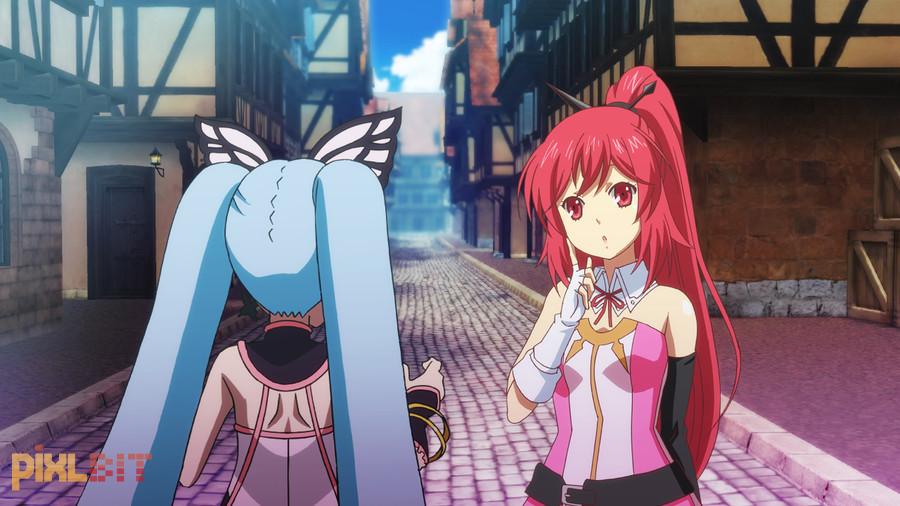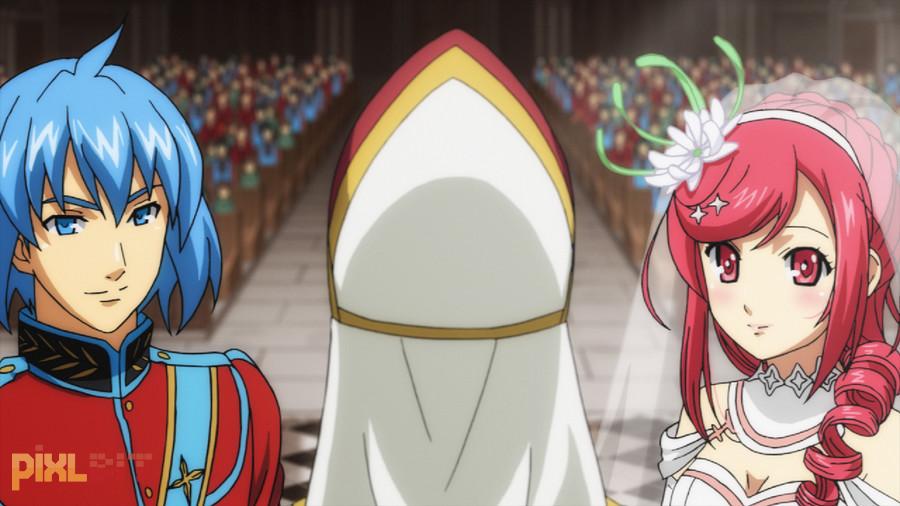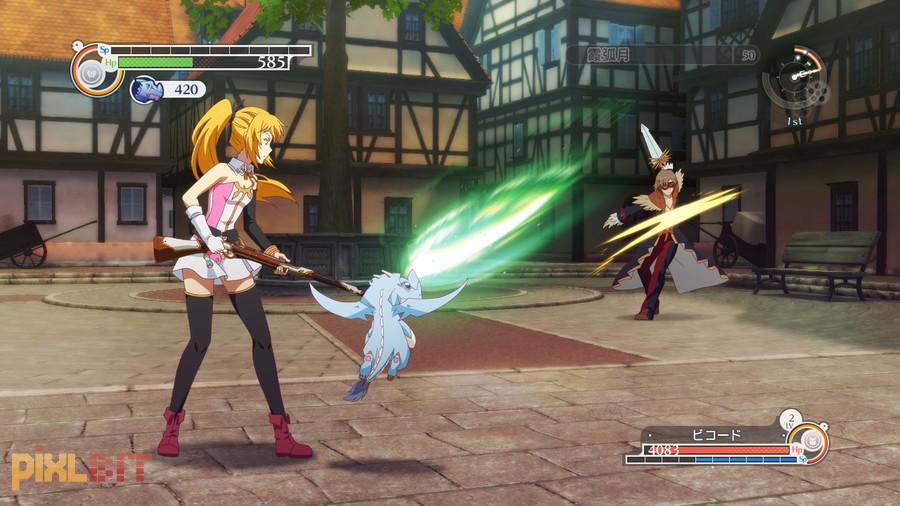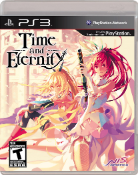
In the last couple of years I’ve had to realize that I’m getting older, and as people get older their tastes gradually change. Time and Eternity is a Japanese-developed RPG that I likely would have loved when I was younger. In fact, I kind of did, as it has a lot of elements that remind me of the PlayStation 1 game Thousand Arms. With its emphasis on hand-drawn graphics and heavily anime inspired themes, Time and Eternity will likely appeal to a lot of people. It just may be that I’m no longer one of them.
I applaud this game for opting for a simpler, more personal storyline, as opposed to the typical “save the world from evil” that so many other RPGs go for. This tale centers on the princess Toki and her husband-to-be, Zack. Their wedding is interrupted when assassins barge in and kill Zack in cold blood. Fortunately, the royal family are Time Keepers, and can travel into the past, inhabiting their own bodies. Toki goes on a quest to get to the bottom of who would possibly want to destroy her wedding, and Zack ends up in the body of her pet dragon, Drake. Oh, and did I mention that Toki has an entirely separate personality living inside of her by the name of Towa? It seems as if Zack is getting himself a red head and a blonde in the process, and he reflects on his good fortune often.

Time and Eternity began with a very clear vision: an RPG with truly HD quality hand-drawn graphics. Normally, I would call the 2D characters “sprites”, but the visuals go far beyond that in this title. Simply put, this game looks just like an anime. In fact, it’s impossible to differentiate the full motion video cutscenes from the actual in-game graphics. This is a truly impressive accomplishment, and I’ve always wanted to see the final evolution of hand-drawn art in video games.
The problem with this is that while Time and Eternity may look just like an anime, it doesn’t look like a very good anime. Instead, this game resembles a low budget, cliché-ridden show from the early ‘90s as opposed to anything recent. The characters look like they were taken out of a “how to draw anime” book: you have the busty brunette with glasses, the haughty blonde rich girl, the pseudo-loli girl with the Sailor Moon braids, and the generic male lead with his shaggy blue hair. On top of that, the mini-dragon version of Zack is crudely drawn, which is extra annoying since he spends the majority of the game in this form.
The animation is stiff and lacks frames, which actually impacts the battle system. To make matters worse, the animation that the game does have is recycled endlessly. When characters are talking they constantly fidget between the same three or four poses, and it’s common to see the same scenes over and over. I saw the exact same series of events play out between three characters on four different occasions. It gives the impression that the game was on a shoestring budget and they needed to utilize every scrap of content they had, even if it didn’t do anything to help the story. Compounding the issue, even though the game is reusing animation multiple times in a scene, it can be common to have the game pause to load mid-cutscene.

The combat system has some interesting ideas, but rarely uses them in interesting ways. Only Toki (or Towa) are playable in combat, and battles are carried out in real time. Each fight starts with the enemy at the far end of the field. From this distance Toki and Towa will use their rifle, and it can be fired over and over with no penalty. Closing the gap will cause them to bring out their knife for melee attacks. However, the choppy animation can make it very difficult to dodge or block enemy moves, and over the course of the game I decided to go for rifle attacks almost exclusively. The key to combat is learning how each enemy moves and then coming up with the correct counter. At first, this was interesting and engaging, but once I learned how each foe operated it became a simple game of rote memorization. This is a game that gets easier as it progresses, and I got to the point where I could get through most fights taking little to no damage.
The magic system adds a lot of depth to the combat, but once again there isn’t enough there to hold interest. Magic shares "SP" with every other ability Toki and Towa can learn (although only a select few can be equipped at once), and doing damage with regular attacks fills the SP meter. However, even the weakest spell will drain half of the SP gauge, so there’s a nice push and pull to how spells are used. Elements are heavily in play, to the point that hitting an enemy with a spell they’re weak to will obliterate it in a single shot. If the spell doesn’t put the monster down there’s a window of opportunity to throw out another spell of a different element. This causes a “chemistry” reaction, which adds some handy debuff effects to the recipient. However, the timing on these chemistry attacks is inconsistent, and magic is so overpowered that it really only comes into play with the small handful of bosses.
Further augmenting the magic system are the time spells that can be unlocked as the game goes on, although these are only found through sidequests. Toki and Towa can rewind time, which resets everything for them but leaves enemy damage intact. In this way, they can hit a monster with a powerful spell up to three times instead of one, provided the time leap is performed correctly. They can later speed up time, which allows them to attack in rapid succession and unleash spells faster. Lastly, they can freeze an enemy in its tracks. However, the time spells are woefully limited, and are only replenished with some rare items or leveling up, so they aren’t as useful as they could be.

Exploration is practically nonexistent. Toki and Towa traverse vast, linear areas with nearly nothing of note to look at. The environments are rendered in 3D, which gives the game an oddly Filmation (read: crappy ‘80s cartoons) look, as the 2D characters stand out like a sore thumb against the bland polygonal backdrops. These areas are huge, but only have one or two destinations. They come across as lifeless and uninspired, compounded by the fact that assets are reused ad nauseum. It gives the impression of level design through the cutting and pasting of a handful of crafted elements, adding to the low-budget impression that Time and Eternity exudes.
I’d also like to express my displeasure with the main character. Although Toki and Towa are the ones doing all the walking and fighting, the game is told through Zack’s perspective. For some reason, Toki and Zack have never kissed, even though they’ve been together for over a year and are about to say their vows when the game begins. As such, Zack’s internal monologue is somewhat of a cesspool. Any little innuendo will set him off, and he positively drools at any mention of Toki taking a bath. It’s a point of view I can’t understand, but maybe I’m just too old now (not likely, as I didn’t think like this as a teenager, either). He’s just a gross character, and even though this is supposed to be a love story I never get that sense from him. It’s a strange tonal element that rubbed me the wrong way throughout the game.
Time and Eternity is a very strange game. It’s gorgeous to look at, and the simple story is refreshing. The time travel elements give the game a hint of the experimental film Run, Lola Run, but even at a brief (by RPG standards) 25 hours the adventure wears out its welcome. The battle system starts off with some interesting ideas that quickly become boring, thanks to predictable enemies and a magic system that’s totally overpowered. The heavy anime wrappings around the game might appeal to some people enough to make Time and Eternity worth their while. If I’m being totally honest, the anime inspirations probably would have appealed to me in the past. I’ve just moved on, and for me, this is a game frozen in time.














 I still plan to get the game, but not after a really good price drop.
I still plan to get the game, but not after a really good price drop. 

Comments